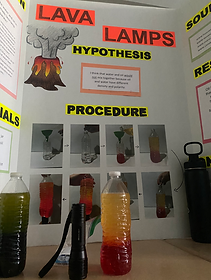WVA Science Fair
April 25, 2024
Important Dates:
April 11th
April 18th
April 23th
April 24th
April 25th
Science Fair Plans are Due - Please print form and turn into your homeroom teacher.
Written Reports are DUE
Oral Visual Presentations
Visual Presentations are due - Judging will take place from 3:00 - 5:00 pm without students
Early release so community members can see all the projects. All presentations will be displayed at the school. Winners will be announced at 3:00PM
Overview

At West Virginia Academy, we celebrate all aspects of discovery. Our PreK through 3rd grade homerooms will participate in a class science fair project. It is never to early to start hypothesizing and experimenting.
Starting in 3rd grade, all scholars are encouraged to participate in the WVA Annual Science Fair. Students can complete these individually or with a partner. Each project will be graded on THREE factors:
Written Report
Be sure your project has each of the following:
TITLE:
Title of the project as well as the name and grade of the student
RESEARCH QUESTION / PURPOSE:
State your purpose as a question or a statement.
-
What are you investigating scientifically?
-
What is it you that you want to find out by doing this project?
HYPOTHESIS
A hypothesis is an educated guess about what you think will occur as a result from completing your experiment.
-
State your hypothesis in an "If.....Then...." statement

RESEARCH / BACKGROUND INFORMATION
Gather your information by reading a book, an article, interviewing an expert in the field, and/or using credible sites on the internet. All information gathered should be summarized and written in this section. DO NOT copy from the source but summarize it in your own words.
MATERIALS
List all materials and supplies used in the project.
Quantities and amounts of each should also be included.
METHODS / PROCEDURE
Describe each step taken to complete the project. List your steps in chronological or numbered order. Remember this is listed so another person can duplicate your project - be as SPECIFIC as you can.

DATA and OBSERVATIONS
These need to be measurable. and show what you learned from the project. Remember to include LABELS such as the date, the time, etc. Make sure you conduct your experiment at least THREE times.
Include:
-
All graphs,
-
Tables,
-
Charts, or
-
Other visual data (pictures)


RESULTS
Summarize your observations in a short paragraph.
CONCLUSION:
Compare your results to the hypothesis. The conclusion should tell whether the hypothesis was proven or not proven. Provide additional experiments that could be done to follow up on your project. Add what you know now that you didn’t know before you completed this project.
REFERENCES / BIBLIOGRAPHY
The bibliography should list all the informational materials you used to research the project. References should be listed in alphabetical order and in MLA format.
Oral Presentation
This will be a THREE (3) minute presentation. Audio/Video presentations created by another company or individual will NOT be permitted. This can be in a slide presentation format, pictures you hold up, demonstrations, or displaying your presentation board. This will take place within your homeroom during the week prior to the science fair. If parents want to see your presentation, please contact the homeroom teacher to arrange the time. VIRTUALLY
HELPFUL HINTS:
-
Wear your uniform and act professionally.
-
Introduce yourself and the title of your project, refer to the presentation DON'T read from it.
-
State your Problem and Hypothesis first.
-
Then give just a few facts you discovered while researching.
-
Tell the steps you took in your experiment as well as the materials you used.
-
Show your tables and graphs.
-
Discuss your results and reveal whether your hypothesis was accurate or proven wrong.
Visual Presentation
Your project will be surrounded by others, to make it stand out REMEMBER the C's!
Color Appeal,
Contrast,
Clear and Concise Statements, and
Completeness
Displays can be made of any material, but must be sturdy enough to stand alone on a table. Please type out responses for easy reading.

Be sure your project adheres to safety restrictions and display regulations. The following are prohibited:
a. Live animals;
b. Flames, highly flammable materials, or sources of heat (hot plates, etc.);
c. Dry ice;
d. Weapons and ammunition (including toys and replicas);
e. Sharp items (for example, syringes, needles, knives);
f. Tobacco products;
g. All hazardous substances or devices (for example—chemicals, poisons, and drugs);
h. Batteries with open-top cells (for example—car and motorcycle batteries);
i. Any item prohibited by county or WV Board of Education Policies; and
j. Any item that the fair coordinator deems unsafe or inappropriate for public display.
Science Fair Do's and Don'ts
-
Do dress neatly (school uniform)
-
Do type all parts and proofread.
-
Do wait quietly until it is your turn to have your project judged
-
Do try to answer the judge’s questions as best as you can.
-
Do not talk or laugh while you are waiting for the judges to comes to your table.
-
Do not play around with your display, or you might damage something before the judges even get to you.
-
Do not chew gum.
-
Do not be nervous. Just do your best.
-
Do have fun!
